2020 Annual Report for: Erebidae / Erebinae
For species seen in 2020 that had less than or equal to 100 records, full details are included; for more common species, the earliest, latest and highest count by vice-county are shown. The narrative for each species is taken from the main Hantsmoths website, and it is possible that some information on abundance and occurrence can get out of date, as it is impossible to keep up with all changes; however it should give a good introduction to each species. The tables in each species account summarise the previous status, and that for the current year.
For the maps, all records prior to 2020 are shown by a blue dot (the larger the dot, the more recent), with the current year's records shown in red. As previous records are superimposed on any report for 2020, new sites have greater emphasis (i.e. will show as 'more red').
In the species accounts, an asterisk next to a location indicates a new 10km square record; earliest ever dates are highlighted in orange, and latest ever in red. Initials in the species accounts refer to the recorders listed here. Please get in touch if you identify any omissions or errors, in particular if you have records that have yet to be submitted. Details of how to submit records can be found here.
72.076 [B&F: 2451] Clifden Nonpareil (Blue Underwing) Catocala fraxini (Linnaeus, 1758) - Recent colonist
A species that was a rare immigrant, temporarily established in Kent and the Norfolk Broads in the past, but which since c. 2005 now appears be making a comeback as a resident species in places. In Hampshire and on the Isle of Wight historically a rare immigrant with up to 1995 about twenty records altogether. Since 2006, the species has started to be recorded more regularly, for example, at Ventnor and Totland on the Island, and at Brockenhurst in the New Forest, and sightings have increased year on year. It is almost certainly resident in a number of localities across southern England (including our area) and while there is the possibility that some of these individuals may have originally originated from deliberate release of captive stock, it is most likely that most populations originate from migrants remaining to breed in this country. Wingspan male 84-100 mm, female 98-112 mm. The original name for this species, Blue Underwing, sums up the identification criteria nicely! Larva feeds on Aspen, no evidence of breeding in the UK.
Records prior to 2020
| Vice County | #Records | #Individuals | First Record | Last Record |
|---|---|---|---|---|
| 10 | 92 | 96 | 1866 | 2019 |
| 11 | 181 | 187 | 1871 | 2019 |
| 12 | 99 | 109 | 1850 | 2019 |
2020 records
| Vice County | #Records | #Individuals | Max Quantity |
|---|---|---|---|
| 10 | 9 | 10 | 2 |
| 11 | 32 | 31 | 2 |
| 12 | 16 | 15 | 1 |
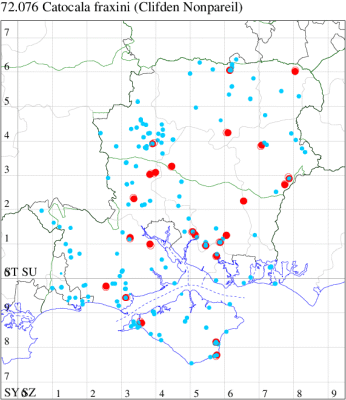
Records by year
Records by week (adult)
Records by week (larval)
Record Details
VC10: Freshwater, one, to actinic, 24 Sep (PBa); Bonchurch, one, 07 Sep; one, 12 Sep; two, 14 Sep; one, 18 Sep; one, 20 Sep; one, 22 Sep (JHa); Shanklin, one, 10 Sep; one, 18 Oct (IOu);
VC11: Marchwood, one, 05 Oct (CTh); Woodlands, New Forest, present, 15 Sep; present, 18 Oct (RBW); Stanbrige Earls, one, to actinic, 13 Aug (JRMi); Ashley, two, to actinic, 22 Sep; Kings Somborne, one, to actinic, 08 Sep (GCE); Botley Wood, one, 18 Sep (F.M.G.); Fareham, one, to actinic, 14 Sep (MLO); Botley, one, to actinic, 14 Aug (SLB); one, field observation, 25 Aug (Unknown); Shirrell Heath, one, 14 Aug; one, 06 Sep (LEdg); Wickham Common, one, 26 Aug; one, 02 Sep; one, 21 Sep; one, 22 Sep; one, 02 Oct; one, 03 Oct; one, 09 Oct; one, 12 Oct; one, 23 Oct; one, 24 Oct (KC); Wickham, one, 30 Aug (JRDS); West Walk, one, 14 Aug; Hen Wood*, one, 04 Sep (F.M.G.); Bournemouth, one, field observation, 08 Sep (LDib); one, field observation, nectaring on ivy blossom, 29 Aug (Unknown); Sway, one, 16 Sep (S&SL); Pennington, one, 04 Oct; one, 17 Oct (RFC);
VC12: Chilbolton, one, to actinic, 19 Sep; one, to actinic, 05 Oct; one, to actinic, 13 Oct (SLE); Anna Valley, Andover, one, 28 Sep (TJN); Crawley, one, to actinic, 26 Aug (GCE); Bulls Bushes Copse, Oakley, one, field observation, 09 Oct (LMor); Beech*, one, 10 Oct (NDP); Preston Candover*, one, 08 Sep (MJW); Pamber Forest, one, 02 Sep (GJD); Steep, one, field observation, 22 Oct (CRob); Liss, one, 18 Sep (LBe); Liss Forest, one, 05 Sep; one, 03 Oct (RJM); Alton, one, to actinic, 14 Sep (BCA); present, field observation, 20 Sep (iNat); Yateley*, one, 08 Sep (JHH)
72.078 [B&F: 2452] Red Underwing Catocala nupta (Linnaeus, 1767) - Common
Common in woodland, parks, scrub, marshes and gardens throughout much of England and Wales. In Hampshire and on the Isle of Wight The most widely distributed of the Catocala group, but less so than formerly. Not particularly attracted to light, which may result in it being under-recorded, but it isn't seen by day resting on tree-trunks in the profusion of a few decades back. Wingspan 75-94 mm. The most likely confusion species are the very much less common Light Crimson Underwing C. promissa and Dark Crimson Underwing C. sponsa, in both of which the subterminal line is strongly dentate, and Rosy Underwing C. electa, in which the forewing is uniformly pale grey, without ochreous tint, the reniform stigma less clearly defined and the postmedian line more strongly dentate subcostally, with a costally directed tooth (MBGBI Vol 10). Larva feeds on Black Poplar, White Poplar, Aspen, Crack Willow and White Willow, over-wintering as an egg.
Records prior to 2020
| Vice County | #Records | #Individuals | First Record | Last Record |
|---|---|---|---|---|
| 10 | 102 | 73 | 1856 | 2019 |
| 11 | 915 | 927 | 1950 | 2019 |
| 12 | 244 | 205 | 1951 | 2019 |
2020 records
| Vice County | #Records | #Individuals | Max Quantity |
|---|---|---|---|
| 10 | 8 | 8 | 1 |
| 11 | 23 | 24 | 2 |
| 12 | 10 | 13 | 3 |
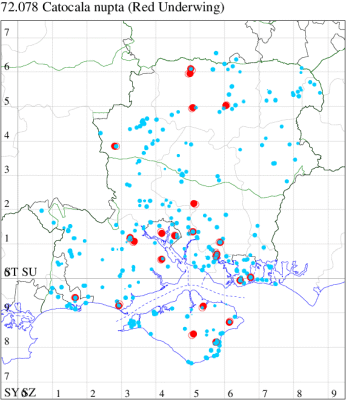
Records by year
Records by week (adult)
Records by week (larval)
Record Details
VC10: Rookley, one, to actinic, 28 Aug (JBa); Shanklin, one, 14 Aug; one, 26 Aug; one, 28 Sep (IOu); Wootton, one, field observation, 03 Aug (KShw); Brading, one, field observation, 11 Sep (JStu det. JBa);
VC11: Woodlands, New Forest, present, 15 Sep (RBW); Ashurst, one, 17 Sep (NSK); Dibden Purlieu, one, 15 Sep (RAC); Southampton, one, field observation, 26 Aug (JVet); Sholing, Southampton, larva, one, field observation, 10 Jun (CFre det. PBu); Fareham, one, dead, 23 Aug (MLO); two, 26 Aug; one, 27 Aug (KJW); Botley, one, to actinic, 04 Jul; one, to actinic, 15 Jul (SLB); Wickham Common, one, 10 Aug (KC); Purbrook, present, field observation, 13 Aug (iNat); Portsmouth, one, 23 Aug; two, 24 Aug; one, 26 Aug; two, 02 Sep; one, 28 Sep (IRT); Lovedean, one, 23 Aug (ARJ); Burton, nr Christchurch, one, 29 Aug (JSw); Milford on Sea, one, 26 Aug (MMcM); Southsea, one, 30 Aug (JGe);
VC12: Over Wallop, two, field observation, 08 Aug (GSD); Ecchinswell, one, to actinic, 25 Sep (MTa, CSu); Marwell Zoological Park, one, field observation, 03 Aug (PEH); Southington, one, field observation, 12 Aug (JHu); Ecchinswell, three, field observation, 16 Aug; one, 07 Sep (MJN); Basingstoke, one, 30 Aug (DLev); Alton, one, 09 Sep (EFig); South Warnborough, one, 29 Aug (PRay)
72.081 [B&F: 2455] Dark Crimson Underwing Catocala sponsa (Linnaeus, 1767) - Nationally Rare
A vulnerable Red Data Book species, in ancient oak woodland in parts of New Forest, also appearing as a migrant in the south, a priority species under the UK Biodiversity Action Plan. Confined as a breeding species to the New Forest in Hampshire. Formerly there were colonies in south Wiltshire until at least 1949. Occasional specimens reported from elsewhere in southern England, including several from north Hampshire and the Isle of Wight, are believed to be migrating or dispersing individuals. Wingspan 58-78 mm. The most likely confusion species are Red Underwing C. nupta and Light Crimson Underwing C. promissa, which see for differences. Larva feeds on Pedunculate Oak and Sessile Oak, over-wintering as an egg.
Records prior to 2020
| Vice County | #Records | #Individuals | First Record | Last Record |
|---|---|---|---|---|
| 10 | 9 | 9 | 1893 | 2018 |
| 11 | 275 | 496 | 1881 | 2019 |
| 12 | 12 | 11 | 1979 | 2019 |
2020 records
| Vice County | #Records | #Individuals | Max Quantity |
|---|---|---|---|
| 10 | 7 | 7 | 1 |
| 11 | 5 | 3 | 1 |
| 12 | 8 | 15 | 5 |
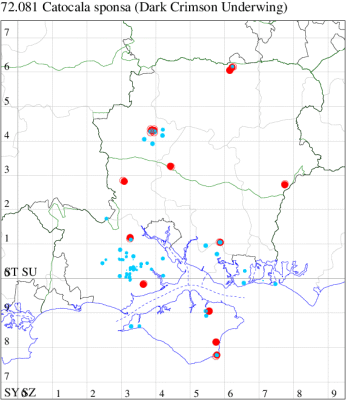
Records by year
Records by week (adult)
Records by week (larval)
Record Details
VC10: Parkhurst Forest*, one, 08 Sep (IM det. TJN); Bonchurch, one, 06 Aug; one, 09 Aug; one, 11 Aug (JHa); Shanklin, one, 06 Jul; Firestone Copse, one, 21 Jul (IOu);
VC11: Woodlands, New Forest, present, 22 Sep (RBW); East Tytherley*, one, to actinic, 14 Sep (GCE); Sholing, Southampton*, one, new to garden, 09 Aug (ARC); Wickham Common, one, 20 Aug (KC); Norleywood, NF, present, 09 Aug (RBW, MWa);
VC12: Harewood Forest, two, to actinic, 23 Jul; one, to actinic, 23 Jul; three, to actinic, 23 Jul; five, to actinic, 23 Jul; Crawley*, one, to actinic, 30 Jul (GCE); Pamber Forest, one, 14 Sep; one, 31 Jul (GJD); Liss*, one, 14 Aug (LBe)
72.082 [B&F: 2454] Light Crimson Underwing Catocala promissa ([Denis & Schiffermüller], 1775) - Nationally Rare
A rare Red Data Book species, in ancient oak woodland in parts of southern England, a priority species under the UK Biodiversity Action Plan. It is now confined to the New Forest and two large woodlands in south Wiltshire. There are also occasional records near the south coast between Dorset and Kent, which may refer to migrants. In Hampshire and on the Isle of Wight now confined to the New Forest; formerly more widespread, including a few records from vice-county 12, and there are two records from the Isle of Wight, in 1979 and 1982. Wingspan 50-66 mm. The most likely confusion species are Red Underwing C. nupta and Dark Crimson Underwing C. sponsa, which see for differences. Larva feeds on Pedunculate Oak and Sessile Oak, over-wintering as an egg.
Records prior to 2020
| Vice County | #Records | #Individuals | First Record | Last Record |
|---|---|---|---|---|
| 10 | 11 | 10 | 1856 | 2018 |
| 11 | 718 | 987 | 1800 | 2019 |
| 12 | 34 | 30 | 1800 | 2019 |
2020 records
| Vice County | #Records | #Individuals | Max Quantity |
|---|---|---|---|
| 10 | 2 | 2 | 1 |
| 11 | 37 | 42 | 2 |
| 12 | 4 | 4 | 1 |
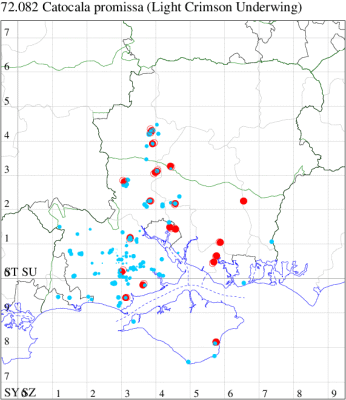
Records by year
Records by week (adult)
Records by week (larval)
Record Details
VC10: Shanklin, one, 25 Jun (IOu);
VC11: Brockenhurst, one, field observation, 03 Aug (PDB); Woodlands, New Forest, one, 13 Jul; one, 16 Jul; two, 27 Jul (RBW); East Tytherley, one, to actinic, 10 Aug (GCE); Romsey, one, 22 May; one, 20 Jun; two, 26 Jun; one, 07 Jul; one, 14 Jul; one, 16 Jul; one, 15 Aug (NRJ); Kings Somborne, one, to actinic, 07 Aug (GCE); Southampton, one, to actinic, 22 Jul (MGP); West End, two, 16 Jul (PAB); Allbrook, one, 07 Jul (SI); Kings Somborne, one, to actinic, 15 Jul (GCE); Fareham*, one, 16 Jul (ADT); one, to actinic, 21 Jul (MLO); Wickham Common*, one, 12 Jul; one, 14 Jul; one, 26 Jul; one, 06 Aug; one, 07 Aug; one, 08 Aug; two, 10 Aug; two, 11 Aug (KC); Lovedean*, one, 24 Jul (ARJ); Hen Wood*, one, 24 Jul (F.M.G.); Pennington, one, 13 Jul; one, 14 Aug; one, 19 Aug (RFC); Pilley Bailey, NF, one, 03 Aug; Norleywood, NF, present, 09 Aug (RBW, MWa);
VC12: Chilbolton, one, to actinic, 28 Jul; Harewood Forest, one, to actinic, 23 Jul; one, to actinic, 23 Jul; Crawley, one, to actinic, 30 Jul (GCE)
72.083 [B&F: 2463] Burnet Companion Euclidia glyphica (Linnaeus, 1758) - Common
Common in grassland, flower meadows, downland, woodland rides, roadside verges and embankments throughout England, Wales and Ireland. Widespread and common in Hampshire and on the Isle of Wight. Wingspan 28-32 mm. Unmistakable. Day-flying. Larva feeds on White and Red Clover, Common Bird's-foot Trefoil, Black Medick, Lucerne and Tufted Vetch, over-wintering as a pupa.
Records prior to 2020
| Vice County | #Records | #Individuals | First Record | Last Record |
|---|---|---|---|---|
| 10 | 97 | 80 | 1880 | 2019 |
| 11 | 528 | 903 | 1950 | 2019 |
| 12 | 1058 | 3201 | 1951 | 2019 |
2020 records
| Vice County | #Records | #Individuals | Max Quantity |
|---|---|---|---|
| 10 | 3 | 3 | 1 |
| 11 | 14 | 20 | 4 |
| 12 | 78 | 150 | 15 |
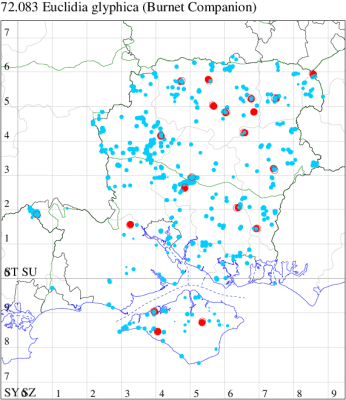
Records by year
Records by week (adult)
Records by week (larval)
Record Details
VC10: Cranmore, one, field observation, 15 May (KNow det. JBa); Brook Chalk Pit, one, field observation, 21 May; Lower Arreton Down, one, field observation, 25 May (KShw);
VC11: Breamore, one, field observation, 27 May (SBra); Stonyford, NF, present, field observation, 16 Jun (RBW); Pitt Down, Farley Mount, four, field observation, 21 May; Hocombe Mead, one, field observation, 05 Jun; one, field observation, 07 Jun (A&LB); Yew Hill NR, Winchester, one, field observation, 05 Jun (SMcL); Otterbourne, one, field observation, 19 Jun (A&LB); Twyford, one, 22 May (SC); Deacon Hill, four, field observation, 24 May (AJB); Claylands LNR, one, field observation, 07 Jun; one, field observation, 26 Jun; one, field observation, 07 Jun (HFir); Catherington Down, one, 08 May (PHog); Old Winchester Hill NNR, two, field observation, 25 May (KF); Lepe, one, field observation, 21 May (MSmi);
VC12: Martin Down NNR, two, field observation, 25 May (DKel); Cholderton, one, field observation, 24 May; one, field observation, 07 May; one, field observation, 19 May (TJN); Leckford, one, field observation, 19 May; one, field observation, 21 May (GCE); Stockbridge Down, one, field observation, 16 May (A&LB); Magdalen Hill Down, one, field observation, 27 May; Bar End, one, field observation, 27 May (DSte); Magdalen Hill Down NR, one, field observation, 21 May (AJB); Magdalen Hill Down, one, field observation, 19 May (CBey); Magdalen Hill Down NR, one, field observation, 21 May (AJB); Barton Stacey, two, field observation, 29 May; two, field observation, 25 May (GCE); Old Burghclere, one, field observation, 24 May (GJD); Magdalen Hill Down, two, field observation, 06 May (CBey); Magdalen Hill Down NR, one, field observation, 21 May (AJB); eight, field observation, 26 May (KF); one, field observation, 06 May; one, field observation, 19 May (CBey); one, field observation, 21 May (AJB); two, field observation, 17 May (A&LB); two, field observation, 21 May (AJB); one, field observation, 24 May; one, field observation, 07 Jun (BJon); 10, field observation, 17 May (A&LB); one, field observation, 24 May; one, field observation, 18 May; two, field observation, 24 May; two, field observation, 31 May; one, field observation, 07 Jun (BJon); Magdalen Hill Down, one, field observation, 26 Apr; one, field observation, 26 Apr; two, field observation, 20 May; one, field observation, 28 May; one, field observation, 28 May; one, field observation, 28 May (DSte); one, field observation, 07 Jul (HFir); A31/A272 Junction, one, field observation, 09 Jun; one, field observation, 25 Jun; Morn Hill, four, field observation, 09 Jun; three, field observation, 09 Jun; eight, field observation, 09 Jun; three, field observation, 25 Jun; one, field observation, 25 Jun (CBey); A31 Winchester, three, field observation, 19 May (DSte); 12, field observation, 09 Jun; one, field observation, 25 Jun (CBey); Hannington, one, field observation, 24 May (ACB); Oakley, one, field observation, 30 May; one, field observation, 26 May (BEv); Ropley, present, field observation, 29 May (TJN); Beggarwood LNR, present, field observation, several, 28 May (DLev); Down Grange Meadow, Kempshott, one, field observation, 07 Jun; one, field observation, 07 Jun (SGdw); Home Farm, Burkham, one, field observation, 08 Jun; Tunworth, one, field observation, 08 May (MEC); Mapledurwell Fen HIWWT, two, field observation, 17 Jun (GJD); Selborne, one, field observation, 31 May (CPip); Noar Hill, one, field observation, 18 May (DKel); one, field observation, 26 Apr (BCA); Odiham Common, one, netted, 19 May (JHH, AMD); 15, 21 May (DAS); Bramshott Common, two, field observation, 18 May; one, field observation, 20 May; one, field observation, 31 May; one, field observation, 13 Jun; three, field observation, 18 May; one, field observation, 20 May; one, field observation, 31 May; one, field observation, 20 May; two, field observation, 31 May; one, field observation, 07 Jun; one, field observation, 17 Jun (AGre); Minley Meadows, two, field observation, 20 May; three, field observation, 20 May; two, field observation, 20 May; one, field observation, 20 May (AHB,CWoo); Hawley Meadows, one, field observation, 09 Jun (KBW)
72.084 [B&F: 2462] Mother Shipton Callistege mi (Clerck, 1759) - Common
Common in open grassland, heathland, moorland, woodland rides and roadside verges throughout much of England, Wales and southern Scotland. In Hampshire and on the Isle of Wight this diurnal species is locally fairly common on downland, in rough grassland and waste places where clovers and trefoils or lucerne occur. Wingspan 30-34 mm. Day-flying. Named after old Mother Shipton, a 16th-century Yorkshire witch. Larva feeds on White Clover, Red Clover, Hare's-foot Clover, Black Medick, Lucerne and Common Bird's-foot Trefoil, over-wintering as a pupa.
Records prior to 2020
| Vice County | #Records | #Individuals | First Record | Last Record |
|---|---|---|---|---|
| 10 | 136 | 107 | 1951 | 2019 |
| 11 | 500 | 548 | 1951 | 2019 |
| 12 | 497 | 603 | 1951 | 2019 |
2020 records
| Vice County | #Records | #Individuals | Max Quantity |
|---|---|---|---|
| 10 | 3 | 3 | 1 |
| 11 | 21 | 26 | 3 |
| 12 | 21 | 29 | 4 |
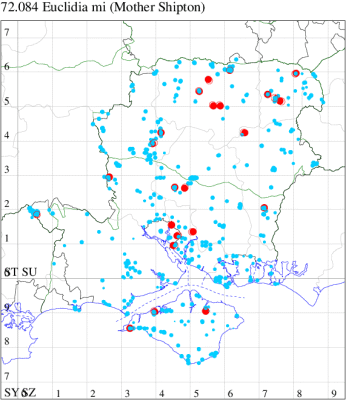
Records by year
Records by week (adult)
Records by week (larval)
Record Details
VC10: West High Down Quarry, larva, one, field observation, 08 Sep (IOu); Cranmore, one, field observation, 26 May (KNow); Briddlesford Copse, one, field observation, 27 May (JBa);
VC11: Mockbeggar, two, field observation, 25 Jun; Blashford Lakes HWT Reserve, one, field observation, 07 Jun (JLev); Bentley Wood, one, field observation, 26 May (A&LB); one, 21 May (NPa); Balmer Lawn, NF, one, field observation, 14 Jun (JGow); Pignal Inclosure, NF, one, field observation, 18 May (A&LB); one, field observation, 21 May (KBro); Hawkhill, one, field observation, 19 May (LHan); Beaulieu Heath North, NF, one, field observation, 19 May (DHan); Lower Test Marshes, one, field observation, 27 May (SKin); Ridges Grove NT, three, field observation, 16 May (A&LB); Netley, one, 01 Jun (MGre); Mansbridge Meadows, Southampton, one, field observation, 21 May (MGP); Donkey Common, Bitterne, one, 18 May (PAB); Pitt Down, Farley Mount, one, field observation, 21 May (A&LB); Yew Hill NR, one, field observation, 13 Jun (EmPe); Twyford, two, 22 May (SC); Deacon Hill, two, field observation, 24 May (AJB); Botley, one, to actinic, 18 May (SLB); Butser Hill, one, field observation, 30 May (JGe);
VC12: Martin Down NNR, two, field observation, 25 May (DKel); Cholderton, two, field observation, 07 May (TJN); Chilbolton, one, field observation, 27 May (GCE); Aldershot, present, field observation, 22 May (iNat); Harewood Common, two, field observation, 07 Jun (PRob); Barton Stacey, one, field observation, 29 May (GCE); Magdalen Hill Down, one, field observation, 24 Apr; Magdalen Hill Down NR, one, field observation, 19 May (CBey); one, field observation, 17 May; four, field observation, 17 May (A&LB); Overton, one, field observation, 21 May; Hannington, one, field observation, 24 May (ACB); Oakley, one, field observation, 26 May (BEv); one, field observation, 24 May; Home Farm, Burkham, one, field observation, 15 May (DLev); Pamber Forest, one, field observation, 04 May (GJD); Bartley Heath, present, field observation, 27 May (PAV); Odiham Common, one, 21 May (DAS); Dogmersfield Lake, three, field observation, 21 May (KBW); Blackbushe Airfield, two, field observation, 08 Jun (JHH); West Minley, four, field observation, 20 May (AHB,CWoo)
72.086 [B&F: 2456] Lunar Double-stripe Minucia lunaris ([Denis & Schiffermüller], 1775) - Migrant
Rare immigrant from southern Europe, appearing in south-eastern England and temporarily resident in east Kent from at least 1942 to 1958. Five immigrants were recorded in 1992. In Hampshire recorded twice, at Lee-on-Solent on 29 May 1954 and at Pennington Marsh on 9 June 2006, and 2020 saw the first for the Isle of Wight. Wingspan 55-62 mm. Larva feeds on Pedunculate Oak, no evidence of breeding in the UK.
Records prior to 2020
| Vice County | #Records | #Individuals | First Record | Last Record |
|---|---|---|---|---|
| 11 | 2 | 2 | 1954 | 2006 |
2020 records
| Vice County | #Records | #Individuals | Max Quantity |
|---|---|---|---|
| 10 | 1 | 1 | 1 |
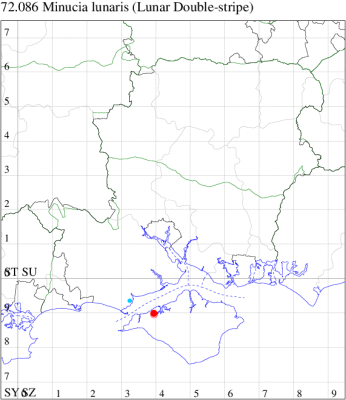
Records by year
Records by week (adult)
Records by week (larval)
Record Details
VC10: New Vice-county Record: Ningwood Common*, one, to actinic, 21 May (JMar)
()().jpg)

(to actinic)().jpg)